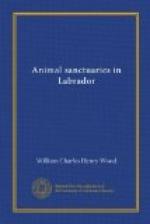Partly because Quebec has taken the lead in legislation, and partly because an ideal site is ready to hand under its jurisdiction, I would venture to suggest the immediate establishment of an absolute sanctuary for all wild birds and mammals along as much of the coast as possible on either side of cape Whittle. The best place of all to keep is from cape Whittle eastward to cape Mekattina, 64 miles in a straight line by sea. The 45 miles from cape Mekattina eastward to Shekatika bay are probably the next best; and, next, the 35 from cape Whittle westward to Cloudberry point. As there are 800 miles between Quebec and the Strait, I am only proposing to make from one-tenth to one-fifth of them into a sanctuary. And this part is the least fitted for other purposes, except sea-fishing, which would not be restricted at all, the least inhabited, and the most likely to succeed as a sanctuary, especially for birds.
Cape Whittle is 550 miles below Quebec, 70 below Natashkwan, which is the last port of call for the mail boats, and 50 below Kegashka, the last green spot along the shore. It faces cape Gregory, near the bay of Islands in Newfoundland, 130 miles across; and is almost as far from the north-east point of Anticosti. It is a great landmark for coasting vessels, and for the seal herds as well. A refuge for seals is absolutely necessary to preserve their numbers and the business connected with them. Of course, I know there is a feeling that, if they are going to disappear, the best thing to do is to exploit them to the utmost in the meanwhile, so as to snatch every present advantage, regardless of consequences. But is this business, sense, or conservation? Even if any restriction in the way of numbers, sex, age or season should be imposed on seal hunting, a small sanctuary cannot but be beneficial. While, if there is no other protection, a sanctuary is a sine qua non. It is possible that some protection might also be afforded to the whales that hug the shore.




